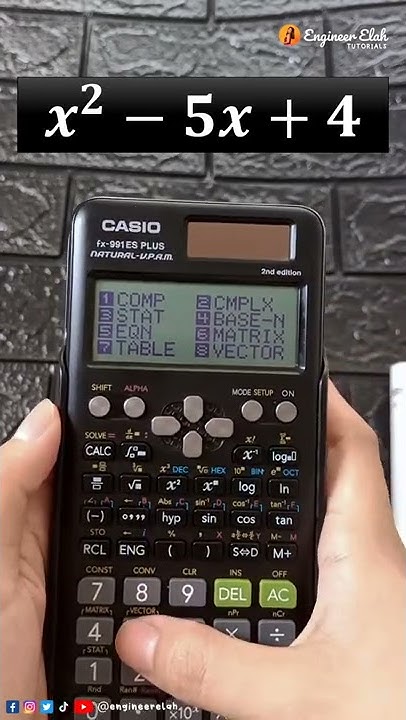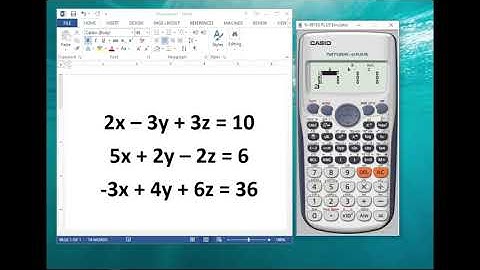$\begingroup$ Show
Is there any general method to solve a Second order ODE with variable coefficient of the form $a(x)y''(x)+b(x)y'(x)+c(x)y(x)=0$
asked Aug 8, 2015 at 19:28
$\endgroup$ $\begingroup$ The equation you have is a second order linear homogeneous ODE. It can be rewritten as $$ y''(x) + b_1(x)\, y'(x) + c_1(x) y(x) = 0, $$ where $b_1 = b/a$ and $c_1 = c/a$ with $a \neq 0$. A general solution of second order linear homogeneous ODE can be obtained in multiple ways, including integration and series expansion. I propose to read this article to get an overview of possible ways to solve it. answered Aug 8, 2015 at 19:42 $\endgroup$ 2 $\begingroup$ In order to successfully approach the problem submitted, the 'Reduction of Order' technique should prove quite useful. Here is a short video that will demonstrate how to solve such a problem with this method: https://www.youtube.com/watch?v=oQSFW8BIrY0&t=627s answered Feb 23, 2018 at 7:58
$\endgroup$ 1 $\begingroup$ The answer is NO. Even an equation as simple as Airy's equation: $$ y''-xy=0, $$ can NOT be solved. Meaning, its solutions can not be expressed in closed form, as expressions of simple functions, their compositions and integrals. The only method which always produces an answer is the method of power series, which works if all the coefficients are expressible as power series (i.e., real analytic). answered Feb 23, 2018 at 10:45
 $\endgroup$ 1
Return To Contents 1. Second-Order Linear Homogeneous Differential Equations With In this section, we'll use the abbreviations:
Recall that a second-order linear homogeneous differential equation with constant coefficients is one of the form: y'' + by' + cy = 0, where the coefficients b and c are constants. When b is replaced by a non-constant function b(x) or c is replaced by a y'' + b(x)y' + c(x)y = 0, where b(x) or
c(x) or both are non-constant functions of x, is said to be an equation with variable coefficients. Note that x is Definition 1.1 � Second-Order Linear
Homogeneous Differential Equations With Variable A differential equation of the form: where b(x) or c(x) or both are non-constant functions, is called a second-order linear homogeneous Recall that while the equation is linear, each function y,
y', and y'' doesn't have to be linear. For example, y = 2x + 3 is linear Return To Top Of Page���� Go To Problems & Solutions Just like the GS of the constant-coefficients HE: y'' + by' + cy = 0 as presented in Section 16.2.1 Theorem 2.2, the GS of the variable-coefficients HE: y'' + b(x)y' + c(x)y = 0 is the linear combination of any two of its linearly independent PSs. The proof of the following theorem is given in a course on Theorem 2.1 � General Solution If y1 and y2 are linearly independent particular solutions of the HE: y'' + b(x)y' + c(x)y = 0, then the GS of this equation is: y = c1y1 + c2 y2, where c1 and c2 are arbitrary constants. Return To Top Of Page���� Go To Problems & Solutions 3. The Method Of Reduction Of Order Recall that to solve a DE is to find its GS. Let's discuss the solving of our equation: By
Theorem 2.1, we obtain the GS of Eq. [3.1] provided we get two linearly independent solutions y1 and y2 of this equation. y = c1y1 + c2y2, where c1 and c2 are arbitrary constants. Clearly y1 = 0 is a solution. But it's not linearly independent of any other solution (0 = Unlike the case of constant-coefficients HEs as developed in Section 16.2.1 Part 3, there's no standard procedure to find two Let y1 be a non-0 solution of Eq. [3.1]. If y2 is another solution that's
linearly independent of y1, then y2/y1 isn't a constant. Indeed y2 is a solution. Now let's verify that it's linearly independent of y1. We have: We've reduced a second-order equation to a first-order equation. The order of the
derivative is reduced. So this approach of We've of course proved the following theorem. Theorem 3.1 �A Solution By The Method Of Reduction Of Order Suppose y1 is a solution of the DE: where c1 and c2 are arbitrary constants. Remark 3.1Example 3.1Consider the DE: x2y'' � xy' + y = 0,���� x > 0, a. Verify that y1 = x is a solution. b. Find a second solution y2 that's
linearly independent of y1 by using the formula obtained by the method of reduction of order. Solution ��� xu'' + u' = 0, ��� �y2 = uy1 = (ln x)x = x ln x. d. Yes. ��� Since ln x isn't a constant, y2 is linearly independent of y1. Thus indeed y2 is a solution that's linearly independent of y1. EOSRemarks 3.2 � About Example 3.1a. In part b, we utilize the formula for y2, which contains the function b(x), so we should write the given equation in the form b. Part c illustrates the following general procedure of the method of reduction of order: ��� � let y2 = uy1 = g(x)u, where y1 = g(x), use g(x) only, not y1, ��� � let v = u',
d. If we're not asked to verify a solution, then we don't have to verify. Remark 3.3It's recommended that you remember the procedure of the method of reduction of order, as outlined in part b of Remarks 3.2 Choosing y2 Suppose it's determined that y2 is a constant multiple of a function, ie that it's of the form y2 = kf(x), where k is a non-0 which isn't constant, since y2/y1 isn't. Thus f(x) is linearly independent of y1. That completes the verification. We've shown that if kf(x), where k is a non-0 constant, is a solution that's linearly independent of
y1, then so is f(x). We Let's look at this possibility from another
angle. If y2 = kf(x), then the GS is y = c1y1 + c2kf(x). Re-using the letter c2 for the
Example 3.2One solution of the DE: xy'' � y' + 4x3y = 0,���� x > 0, is y1 = sin (x2). Solve the equation. Solution Let u = x2. So du = 2x dx. Then: So, choosing y2 = cos
(x2), the GS is y = c1 sin (x2) + c2 cos (x2). Return To Top Of Page���� Go To Problems & Solutions 4. For Constant-Coefficients Equations The procedure of the method of reduction of order doesn't require that the coefficients be variable functions. So the method Example 4.1Consider the constant-coefficients DE: y'' + 5y' + 6y = 0. a. Solve it by using the method of characteristic equation. Solution ��� �So, choosing y2 = e�3x, the GS is y = c1e�2x + c2e�3x. c. Yes. Return To Top Of Page Problems & Solutions1. Consider the Legendre equation of order 1: ��� (1 � x2)y'' � 2xy' + 2y = 0,���� |x| < 1. ��� a. Verify that y1 = x is a solution. ��� b. Find a second solution y2 that's linearly independent of y1 by using the formula obtained by the method of reduction of order. Solution��� Let u = 1 � x2. So du = �2x dx. Then: ��� Using the method of partial fractions we have: ���� C = 0, �� ��� Using the method of partial fractions we have: �� �� ��� Using the method of partial fractions we have: �� d. Yes. e) Let's show that y2 is a solution: ��� So indeed y2 is a solution. Now let's show that it's linearly independent of y1: ��� which clearly isn't constant. Thus indeed y2 is linearly independent of y1. Return To Top Of Page 2. Consider the DE: ��� x2y'' � 2xy' + (x2 + 2)y = 0,���� x > 0. ��� a. Verify that y1 = x sin x is a solution. Solution��� Choose y2 = xcosx. So the GS of the given equation is y = c1xsinx + c2xcosx, or: ��� y = x(Acosx + Bsinx), ��� where A = c2 and B = c1 are arbitrary constants. Return To Top Of Page 3. Consider the constant-coefficients DE: ��� y'' + y' + 7y = 0. a. Verify that: �� ��� is a solution. b. Use y1 to solve the equation. NoteWe're required to use y1 to solve the equation. So we can't apply the method of characteristic equation, which
doesn't use y1. Solution��� Indeed y1 is a solution. b. Let y2 be another solution that's linearly independent of y1. Then by the method of reduction of order we have: �� �� ��� where A = c2 and B = c1 are arbitrary constants. Return To Top Of Page 4. Consider the Bessel DE: ��� x2y'' + xy' + (x2 � p2)y = 0,���� p a constant. ��� For p = 1/2 and x > 0:
Solutiona. When p = 1/2 the given equation becomes:
��� where A and B are arbitrary constants. Return To Top Of Page 5. Given the DE: ��� xy'' � (x + n)y' + ny = 0,���� x > 0,���� integer constant n > 0, ��� verify that y1 = ex is a solution and determine another solution linearly independent of y1. Solution Let's verify that y1 is a solution. We have: Thus: In = � xne�x + nIn�1 �� = � e�x(xn) + n(� xn�1e�x + (n � 1)In�2) �� = � e�x(xn + nxn�1) + n(n � 1)(� xn�2e�x + (n � 2)In�3) �� = � e�x(xn + nxn�1 + n(n � 1)xn�2) + n(n � 1)(n � 2)(� xn�3e�x + (n � 3)In�4) �� = � e�x(xn + nxn�1 + n(n � 1)xn�2 + n(n � 1)(n � 2)xn�3) + n(n � 1)(n �2)(n � 3)(� xn�4e�x + (n � 4)In�5) Return To Top Of Page���� Return To Contents What is second order differential equation with variable coefficients?The second-order linear differential equations with variable coefficients are differential equations whose coefficients are a function of a certain variable. A second-order linear differential equation has a general form. d 2 y d x 2 + P d y d x + Q y = R. where P, Q and R are functions of the independent variable x.
What is second order differential equation with examples?The differential equation y'' + p(x)y' + q(x)y = f(x) is called a second order differential equation with constant coefficients if the functions p(x) and q(x) are constants. Some of its examples are y'' + y' - 6y = x, y'' - 9y' + 20y = sin x, etc.
|

Related Posts
Advertising
LATEST NEWS
Advertising
Populer
Advertising
About

Copyright © 2024 boxhoidap Inc.


















